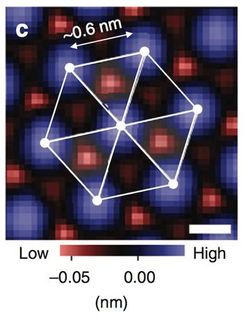Tunnel view of how electrons play
Scanning tunnelling microscopes provide insights into mysterious electronic effects in some metals
Electrons behave like football teams: the match becomes interesting when the teamwork is as good as that conjured up by the players of FC Barcelona. Electrons which interact strongly with each other give rise to superconductivity, the lossless transport of current, for example. A team headed by researchers at the Max Planck Institute for Chemical Physics of Solids in Dresden is now taking a completely new look at the teamwork between electrons. They have used a scanning tunnelling microscope to investigate the Kondo effect in the metal ytterbium rhodium silicide YbRh2Si2, which contains unpaired electrons and thus magnetic moments. At low temperatures, the strong interactions between the electrons completely shield the magnetic moments from each other. The Dresden-based physicists have now observed how this shielding is created. Their work also shows how well electronic processes in solids can be investigated with scanning tunnelling microscopes.
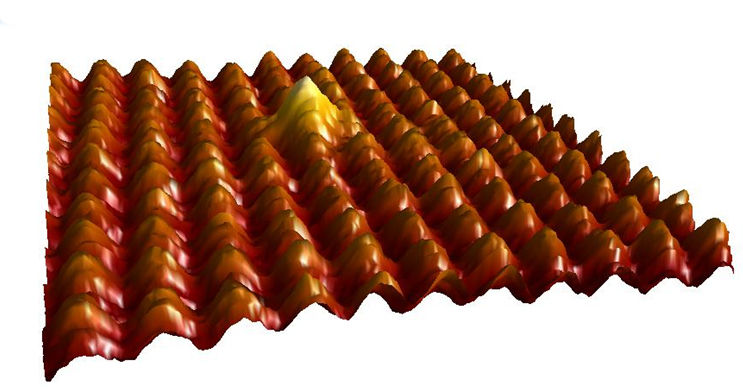
An almost perfect surface: The image shows a regularly ordered layer of silicon atoms with a defect where a silicon atom is replaced by a bigger ytterbium atom. In the sample surfaces examined by the Dresden physicists there are only 70 defects among around 30,000 atoms – ideal conditions for convincing measurements.
© Steffen Wirth / MPI for Chemical Physics of Solids
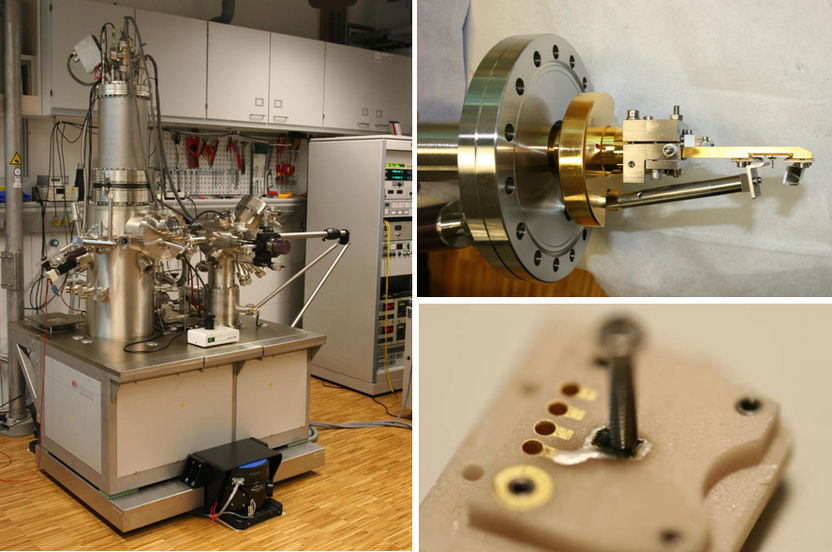
Microscope with built-in sample cleavage mechanism: The commercial scanning tunnelling microscope (left) allows measurements at low temperatures. It contains a device with which parts of the sample can be broken away to produce a surface which is as clean as possible and contains as few defects as possible. The physicists use a rod (top right) to knock off a small screw which has been bonded to the sample, thus taking a few layers of the material with it. The screw almost completely covers the sample, which is bonded to a ceramic holder (bottom right).
© Steffen Wirth / MPI for Chemical Physics of Solids
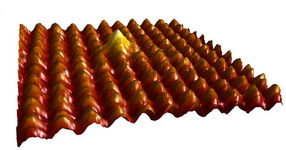
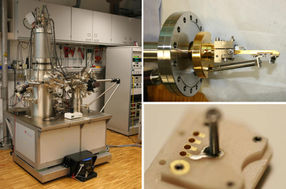
Events in solid bodies only become interesting when the temperature drops far below freezing, as the atoms then oscillate more slowly and interfere less with the motion of the electrons. The charge carriers therefore experience the forces between each other much more intensely and become aware that they have completely different possibilities apart from conducting electricity or not conducting it. In order to gain a better understanding of the electronic processes in solids, which are the basis of chip technology, communications and modern medical engineering, physicists also investigate the extraordinary effects that electrons in solids display at low temperatures. In future, this understanding may possibly help to produce materials with new properties that may be interesting for technical developments.
“With our current work, we are opening a door that provides us with a completely new way of accessing a large number of electronic phenomena in solids,” says Steffen Wirth, who headed the study. The investigation involved not only the researchers of the Max Planck Institute for Chemical Physics of Solids, but also scientists from the Max Planck Institute for the Physics of Complex Systems, also in Dresden, and the Technical University Braunschweig. The team investigated the metal ytterbium rhodium silicide YbRh2Si2 with a scanning tunnelling microscope as they slowly cooled down the metal.
Physicists also call the material heavy fermion metal; they often talk of fermions when they mean certain properties of electrons. The charged particles are naturally very light but become heavy as a result of the extraordinary effects that are based on the strong interplay of the electrons. The main players here are unpaired localized electrons, i.e. electrons which are firmly bound to the rare earth metal ytterbium. These electrons can occupy any of four groups of 4f orbitals, each with a different shape, assist with the transport of current in the material and have magnetic moments – these are the properties that arouse physicists’ interest.
The Dresden-based researchers have now shown that the interplay between the localized 4f electrons and the freely moving conduction electrons of the material can be observed with a scanning tunnelling microscope. This reveals a great deal about the causes of the effects, and thus about the physical laws in such materials.
The investigation involves positioning the tip of the microscope above a sample surface made up of very well ordered silicon atoms situated one next to the other (see Background: Purity law for a sample surface). The researchers then measure how the tunnelling current depends on the voltage applied at different temperatures. The more they cool the sample, the more marked is the appearance of several peaks and a deep dip in the current-voltage curve. These peaks and troughs in the measured current tell the researchers what happens to the electrons in the material. It is not always easy to interpret the characteristics in the current-voltage curve, however.
At low temperatures, quasi-particles are formed
“We can unequivocally assign the three peaks which occur at distinct energies,” says Steffen Wirth. Thus at – 17, – 27 and – 43 millivolts relatively large numbers of electrons tunnel from the sample to the microscope tip. These voltages correspond to energies where the electrons collect more or less in bands. The bands are caused by the crystal field splitting: if the 4f electrons of the ytterbium choose to occupy those orbital groups of the four possible ones where they avoid neighbouring atoms in the crystal as much as possible, they save energy. The corresponding band is therefore at lower energies than one where the electrons may meet their neighbours in the crystal. The effect itself has been known for quite a while. “We are the first to observe the crystal field splitting in the scanning tunnelling microscope,” says Steffen Wirth. From these bands with the different energies the electrons then tunnel into the microscope tip.
The fact that the crystal field splitting becomes visible in the tunnelling microscope also shows the researchers that they are measuring not only surface properties, but mostly properties of the interior of their samples. “This was not clear before the investigation,” says Steffen Wirth. Scanning tunnelling microscopes are particularly sensitive to the characteristics of the surface and everything which lies or happens on it. It could also have been the case that the physicists saw only special effects of the surface. “We can now exclude this,” says Wirth.
This is also one of the reasons why the physicists in Dresden are quite confident in their explanation as to why the tunnelling current collapses when the voltage decreases to zero. At low temperatures, hardly any current continues to flow between the sample and the tip of the tunnelling microscope. The researchers put this decrease down to the Kondo effect on individual ytterbium atoms – the very phenomenon which the experiments were actually designed to investigate.
The 4f electrons, which are localized at the ytterbium atoms, rotate about their own axis and thus create the usual magnetic moments of the ytterbium atoms – physicists call this rotation spin. The Kondo effect causes the conduction electrons, which transport the current, to form quasi-particles with these magnetic moments at around minus 170 degrees Celsius. These quasi-particles can possibly be visualized as a cloud of the local magnetic moments and the conduction electrons surrounding them. The spins of the conduction electrons here are oriented in precisely the opposite direction to the spins of the local 4f electrons and thus shield the magnetic moments of the 4f electrons. Since the quasi-particles are relatively heavy compared to an individual electron, the heavy fermion metals have been named after them.
“We assume that fewer and fewer conduction electrons contribute to the tunnelling conductivity at temperatures below minus 170 degrees Celsius, because they are increasingly bound in quasi-particles,” says Steffen Wirth. “We therefore take the decrease of the tunnelling current to be strong evidence for the Kondo effect.”
Wirth and his colleagues can interpret the final conspicuous detail of the tunnelling current curve with less clarity: a hump at - 6 millivolts, which only occurs below minus 245 degrees Celsius, but markedly dents the current-voltage curve at minus 268 degrees Celsius. “We interpret this as an indication of a Kondo lattice,” says Steffen Wirth. Quasi-particles formed by the Kondo effect join together to form a Kondo lattice. The quasi-particles then cease to lead an isolated existence in the material, but interact with each other. This process also leads them to form an energy band, in which the mixture of 4f and conduction electrons likes to be – this is the assumption.
“Whether a Kondo lattice exists and when it forms is a very controversial issue,” says Steffen Wirth. Some physicists assume that the lattice forms before the quasi-particles. “I cannot imagine that physically,” says Steffen Wirth: “And we actually observe the decrease of the tunnelling current at higher temperatures than the signal which we assume to be caused by the Kondo lattice,” explains Wirth. If the interpretation of the signal at – 6 millivolts is correct, the quasi-particles would only form a lattice after they have been produced, as corresponds to the natural sequence of cause and effect.
More than enough possibilities in the lifetime of one researcher
It is precisely the interpretation of the signal at – 6 millivolts where the Dresden physicists are not quite certain; calculations which they have done in parallel to their experiments predict the signal will be at around – 2 millivolts. The researchers find the signals of the crystal field splitting at exactly the position where they should be in theory. “It is therefore not clear whether we are really seeing the band of the Kondo lattice,” says Wirth.
The physicists now intend to investigate the discrepancy in more detail; however, this is not the only direction they can now follow. “After our initial investigation with a scanning tunnelling microscope provided such a detailed image of the electronic structure of heavy fermion metals, we now have more possibilities than can be covered in the lifetime of one researcher,” says Steffen Wirth. He and his colleagues therefore want to find out what the current-voltage curve looks like when ytterbium rather than silicon forms the top atomic layer. The researchers also want to add traces of further elements to the ytterbium rhodium silicide, which would probably change its electronic properties considerably. In addition, the researchers want to measure the tunnelling current at temperatures far below minus 268 degrees Celsius. This is where the Kondo effect is assumed to break down, and the 4f electrons take on an anti-ferromagnetic order.
“If we expand the method further, we may also be able to make a contribution to explaining the unconventional superconductivity in heavy fermion metals,” says Steffen Wirth. And that would provide a relatively strong clue as to how so-called high-temperature superconductivity comes about. This is promising in technical terms, although it still begins at temperatures far below freezing. Only when physicists accurately understand its causes can they look for materials that lose their resistance under ordinary conditions.
